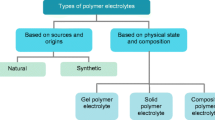Abstract
Polymers that exhibit high electrical conductivity have successfully been synthesized in the last few decades. The early problems associated with the stability and solubility of such conducting polymers have largely been overcome using chemical intuition and experimentation. A fairly wide range of interesting applications based on these polymers is emerging; some of these are highlighted in this article.
Similar content being viewed by others
Suggested Reading
T Skotheim.Handbook of Conducting Polymers Vol I & II. Marcel Dekker. New York, 1986.
W R Salaneck, D T Clark and E J Samuelsen.Science and Applications of Conduc ting Polymers. Published by Adam Hilger. Bristol, 1991.
J A Chilton and M T Goosey.Special Polymers for Electronics and Optoelectronics. Chapter 1. Chapman & Hall. London, 1995.
A K Shukla and P Vishnu Kamath.Resonance. Vol. 1. June, 1996.
Author information
Authors and Affiliations
Rights and permissions
About this article
Cite this article
Ramakrishnan, S. Conducting polymers. Reson 2, 48–58 (1997). https://doi.org/10.1007/BF02862641
Issue Date:
DOI: https://doi.org/10.1007/BF02862641




